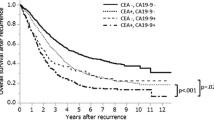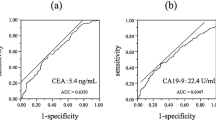Abstract
Background
We evaluated the efficiency of CEA and CA19-9 as tools for diagnosing recurrence in the postoperative surveillance of colorectal cancer.
Materials and Methods
A total of 227 patients who underwent curative resection for colorectal cancer between 1999 and 2003 at our hospital received complete follow-up according to the schedule determined prospectively. Using receiver operating characteristic (ROC) analysis, performance of postoperative values of CEA or CA19-9 for detecting recurrence was assessed.
Results
The sensitivity (1.000) and specificity (0.978) of the postoperative values of CEA in the high preoperative CEA group were very high. Even in the normal preoperative CEA group, the area under the curve (AUC) of the ROC curve of CEA (0.740, 95% confidence interval [95% CI], 0.628–0.852) was significantly larger than 0.5 (P < 0.001). The postoperative values of CA19-9 showed high sensitivity (0.833) and specificity (0.900) in the high preoperative CA19-9 group, while the AUC of the ROC curve of the normal preoperative group was as small as 0.510 (95% CI, 0.376–0.644). In the high preoperative CA19-9 group, however, there was no significant difference between the AUC of CA19-9 (0.904, 95% CI, 0.786–1.000) and that of CEA (0.869, 95% CI, 0.744–0.994) (P = 0.334).
Conclusions
The measurement of CEA is an efficient way to detect recurrence. The efficiency of measuring CA19-9 for the purpose of detecting recurrence is low, especially in patients with a normal level of preoperative CA19-9. Even in patients with a high preoperative level of CA19-9, CEA might be able to fill the role of CA19-9.






Similar content being viewed by others
References
Tjandra JJ, Chan MK. Follow-up after curative resection of colorectal cancer: a meta-analysis. Dis Colon Rectum. 2007;50:1783–99.
Rodriguez-Moranta F, Saló J, Arcusa A, Boadas J, Piñol V, Bessa X, et al. Postoperative surveillance in patients with colorectal cancer who have undergone curative resection: a prospective, multicenter, randomized, controlled trial. J Clin Oncol. 2006;24:386–93.
Desch CE, Benson AB 3rd, Somerfield MR, Flynn PJ, Krause C, Loprinzi CL, et al. Colorectal cancer surveillance: 2005 update of an American Society of Clinical Oncology practice guideline. J Clin Oncol. 2005;23:8512–9.
Figueredo A, Rumble RB, Maroun J, Earle CC, Cummings B, McLeod R, et al. Follow-up of patients with curatively resected colorectal cancer: a practice guideline. BMC Cancer. 2003;3:26.
McArdle C. ABC of colorectal cancer: effectiveness of follow up. BMJ. 2000;321:1332–5.
Ohlsson B, Breland U, Ekberg H, Graffner H, Tranberg KG. Follow-up after curative surgery for colorectal carcinoma. Randomized comparison with no follow-up. Dis Colon Rectum. 1995;38:619–26.
Grossmann I, de Bock GH, van de Velde CJ, Kievit J, Wiggers T. Results of a national survey among Dutch surgeons treating patients with colorectal carcinoma. Current opinion about follow-up, treatment of metastasis, and reasons to revise follow-up practice. Colorectal Dis. 2007;9:787–92.
Jeffery M, Hickey BE, Hider PN. Follow-up strategies for patients treated for non-metastatic colorectal cancer. Cochrane Database Syst Rev. 2007:CD002200.
Secco GB, Fardelli R, Gianquinto D, Bonfante P, Baldi E, Ravera G, et al.. Efficacy and cost of risk-adapted follow-up in patients after colorectal cancer surgery: a prospective, randomized and controlled trial. Eur J Surg Oncol. 2002;28:418–23.
Locker GY, Hamilton S, Harris J, Jessup JM, Kemeny N, Macdonald JS, et al.. ASCO 2006 update of recommendations for the use of tumor markers in gastrointestinal cancer. J Clin Oncol. 2006;24:5313–27.
Duffy MJ, van Dalen A, Haglund C, Hansson L, Klapdor R, Lamerz R, et al. Clinical utility of biochemical markers in colorectal cancer: European Group on Tumour Markers (EGTM) guidelines. Eur J Cancer. 2003;39:718–27.
Kouri M, Pyrhonen S, Kuusela P. Elevated CA19-9 as the most significant prognostic factor in advanced colorectal carcinoma. J Surg Oncol. 1992;49:78–85.
Chen CC, Yang SH, Lin JK, Lin TC, Chen WS, Jiang JK, et al. Is it reasonable to add preoperative serum level of CEA and CA19-9 to staging for colorectal cancer? J Surg Res. 2005;124:169–74.
Morita S, Nomura T, Fukushima Y, Morimoto T, Hiraoka N, Shibata N. Does serum CA19-9 play a practical role in the management of patients with colorectal cancer? Dis Colon Rectum. 2004;47:227–32.
Eche N, Pichon MF, Quillien V, Gory-Delabaere G, Riedinger JM, Basuyau JP, et al. [Standards, options and recommendations for tumor markers in colorectal cancer]. Bull Cancer. 2001;88:1177–206.
Barillari P, Bolognese A, Chirletti P, Cardi M, Sammartino P, Stipa V. Role of CEA, TPA, and Ca 19-9 in the early detection of localized and diffuse recurrent rectal cancer. Dis Colon Rectum. 1992;35:471–6.
Ueda T, Shimada E, Urakawa T. The clinicopathologic features of serum CA 19-9-positive colorectal cancers. Surg Today. 1994;24:518–25.
JSCCR. Japanese Classification of Colorectal Carcinoma Second English Edition. Japanese Society for Cancer of the Colon and Rectum. 2009.
Hanley JA, McNeil BJ. The meaning and use of the area under a receiver operating characteristic (ROC) curve. Radiology. 1982;143:29–36.
Metz CE. ROC methodology in radiologic imaging. Invest Radiol. 1986;21:720–33.
Hanley JA, McNeil BJ. A method of comparing the areas under receiver operating characteristic curves derived from the same cases. Radiology. 1983;148:839–43.
Chan I, Wells W 3rd, Mulkern RV, Haker S, Zhang J, Zou KH, et al. Detection of prostate cancer by integration of line-scan diffusion, T2-mapping and T2-weighted magnetic resonance imaging; a multichannel statistical classifier. Med Phys. 2003;30:2390–8.
Zweig MH, Campbell G. Receiver-operating characteristic (ROC) plots: a fundamental evaluation tool in clinical medicine. Clin Chem. 1993;39:561–77.
Baker SG. The central role of receiver operating characteristic (ROC) curves in evaluating tests for the early detection of cancer. J Natl Cancer Inst. 2003;95:511–5.
Shlipak MG, Fried LF, Cushman M, Manolio TA, Peterson D, Stehman-Breen C, et al. Cardiovascular mortality risk in chronic kidney disease: comparison of traditional and novel risk factors. JAMA. 2005;293:1737–45.
Gardner IA, Greiner M. Receiver-operating characteristic curves and likelihood ratios: improvements over traditional methods for the evaluation and application of veterinary clinical pathology tests. Vet Clin Pathol. 2006;35:8–17.
Simel DL, Samsa GP, Matchar DB. Likelihood ratios with confidence: sample size estimation for diagnostic test studies. J Clin Epidemiol. 1991;44:763–70.
Choi BC. Slopes of a receiver operating characteristic curve and likelihood ratios for a diagnostic test. Am J Epidemiol. 1998;148:1127–32.
Fischer JE, Bachmann LM, Jaeschke R. A readers’ guide to the interpretation of diagnostic test properties: clinical example of sepsis. Intensive Care Med. 2003;29:1043–51.
Pencina MJ, D’Agostino RB Sr, D’Agostino RB Jr, Vasan RS. Evaluating the added predictive ability of a new marker: from area under the ROC curve to reclassification and beyond. Stat Med. 2008;27:157–72 (discussion 207–12).
Lokich J, Ellenberg S, Gerson B, Knox WE, Zamcheck N. Plasma clearance of carcinoembryonic antigen following hepatic metastatectomy. J Clin Oncol. 1984;2:462–5.
Goonetilleke KS, Siriwardena AK. Systematic review of carbohydrate antigen (CA 19-9) as a biochemical marker in the diagnosis of pancreatic cancer. Eur J Surg Oncol. 2007;33:266–70.
Yoshimasu T, Maebeya S, Suzuma T, Bessho T, Tanino H, Arimoto J, et al. Disappearance curves for tumor markers after resection of intrathoracic malignancies. Int J Biol Markers. 1999;14:99–105.
Korner H, Soreide K, Stokkeland PJ, Soreide JA. Diagnostic accuracy of serum-carcinoembryonic antigen in recurrent colorectal cancer: a receiver operating characteristic curve analysis. Ann Surg Oncol. 2007;14:417–23.
Park IJ, Choi GS, Lim KH, Kang BM, Jun SH. Serum carcinoembryonic antigen monitoring after curative resection for colorectal cancer: Clinical significance of the preoperative level. Ann Surg Oncol. 2009;16:3087–93.
Nakayama T, Watanabe M, Teramoto T, Kitajima M. CA19-9 as a predictor of recurrence in patients with colorectal cancer. J Surg Oncol. 1997;66:238–43.
Yamashita K, Watanabe M. Clinical significance of tumor markers and an emerging perspective on colorectal cancer. Cancer Sci. 2009;100:195–9.
Author information
Authors and Affiliations
Corresponding author
Rights and permissions
About this article
Cite this article
Yakabe, T., Nakafusa, Y., Sumi, K. et al. Clinical Significance of CEA and CA19-9 in Postoperative Follow-up of Colorectal Cancer. Ann Surg Oncol 17, 2349–2356 (2010). https://doi.org/10.1245/s10434-010-1004-5
Received:
Published:
Issue Date:
DOI: https://doi.org/10.1245/s10434-010-1004-5




